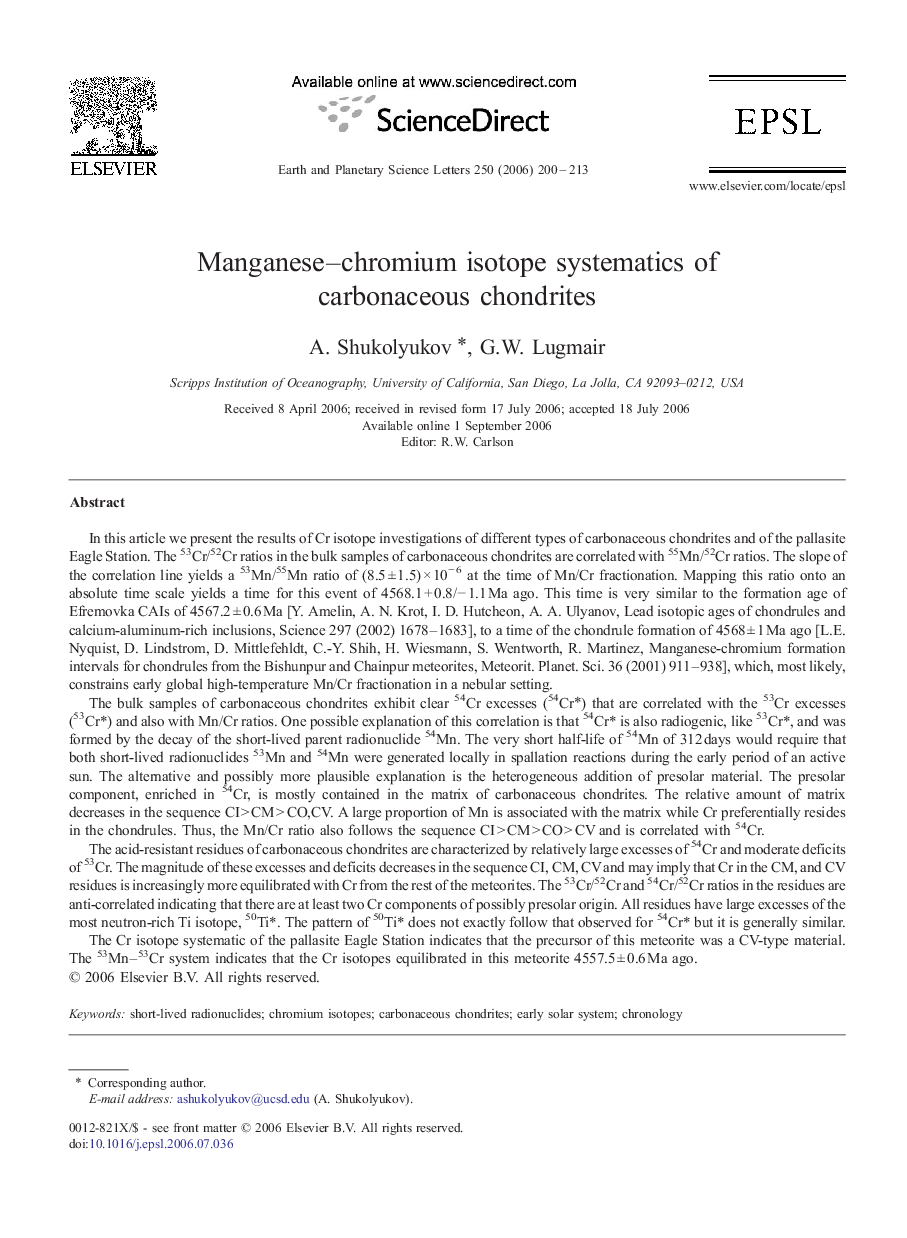| کد مقاله | کد نشریه | سال انتشار | مقاله انگلیسی | نسخه تمام متن |
|---|---|---|---|---|
| 4680697 | 1634935 | 2006 | 14 صفحه PDF | دانلود رایگان |

In this article we present the results of Cr isotope investigations of different types of carbonaceous chondrites and of the pallasite Eagle Station. The 53Cr/52Cr ratios in the bulk samples of carbonaceous chondrites are correlated with 55Mn/52Cr ratios. The slope of the correlation line yields a 53Mn/55Mn ratio of (8.5 ± 1.5) × 10− 6 at the time of Mn/Cr fractionation. Mapping this ratio onto an absolute time scale yields a time for this event of 4568.1 + 0.8/− 1.1 Ma ago. This time is very similar to the formation age of Efremovka CAIs of 4567.2 ± 0.6 Ma [Y. Amelin, A. N. Krot, I. D. Hutcheon, A. A. Ulyanov, Lead isotopic ages of chondrules and calcium-aluminum-rich inclusions, Science 297 (2002) 1678–1683], to a time of the chondrule formation of 4568 ± 1 Ma ago [L.E. Nyquist, D. Lindstrom, D. Mittlefehldt, C.-Y. Shih, H. Wiesmann, S. Wentworth, R. Martinez, Manganese-chromium formation intervals for chondrules from the Bishunpur and Chainpur meteorites, Meteorit. Planet. Sci. 36 (2001) 911–938], which, most likely, constrains early global high-temperature Mn/Cr fractionation in a nebular setting.The bulk samples of carbonaceous chondrites exhibit clear 54Cr excesses (54Cr⁎) that are correlated with the 53Cr excesses (53Cr⁎) and also with Mn/Cr ratios. One possible explanation of this correlation is that 54Cr⁎ is also radiogenic, like 53Cr⁎, and was formed by the decay of the short-lived parent radionuclide 54Mn. The very short half-life of 54Mn of 312 days would require that both short-lived radionuclides 53Mn and 54Mn were generated locally in spallation reactions during the early period of an active sun. The alternative and possibly more plausible explanation is the heterogeneous addition of presolar material. The presolar component, enriched in 54Cr, is mostly contained in the matrix of carbonaceous chondrites. The relative amount of matrix decreases in the sequence CI > CM > CO,CV. A large proportion of Mn is associated with the matrix while Cr preferentially resides in the chondrules. Thus, the Mn/Cr ratio also follows the sequence CI > CM > CO > CV and is correlated with 54Cr.The acid-resistant residues of carbonaceous chondrites are characterized by relatively large excesses of 54Cr and moderate deficits of 53Cr. The magnitude of these excesses and deficits decreases in the sequence CI, CM, CV and may imply that Cr in the CM, and CV residues is increasingly more equilibrated with Cr from the rest of the meteorites. The 53Cr/52Cr and 54Cr/52Cr ratios in the residues are anti-correlated indicating that there are at least two Cr components of possibly presolar origin. All residues have large excesses of the most neutron-rich Ti isotope, 50Ti⁎. The pattern of 50Ti⁎ does not exactly follow that observed for 54Cr⁎ but it is generally similar.The Cr isotope systematic of the pallasite Eagle Station indicates that the precursor of this meteorite was a CV-type material. The 53Mn–53Cr system indicates that the Cr isotopes equilibrated in this meteorite 4557.5 ± 0.6 Ma ago.
Journal: Earth and Planetary Science Letters - Volume 250, Issues 1–2, 15 October 2006, Pages 200–213